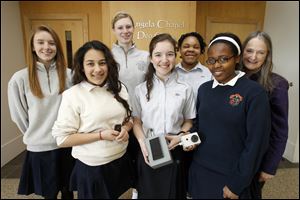
Students' sound idea leads to big prize
Device to help St. Ursula chaplain modified to help others
3/15/2012At first, the girls at St. Ursula Academy wanted to help their priest find his way through sound. Now, their vision continues to expand, and they're reaping rewards.
Students in St. Ursula's Science, Technology, Engineering, and Math club developed a sonic device last year to help Ursuline Sisters' chaplain, the Rev. Ric Saelzler, who is visually impaired, better navigate the campus. They entered the device in contests but just barely missed out on the finals of the AbilityOne Network Design Challenge.
Instead of giving up last year, the team went back to the drawing board. The members improved the device -- which they call the Pathway -- and expanded its use. While Father Saelzler was the Pathway's inspiration, students also worked with the Sight Center of Northwestern Ohio, modifying the device to be placed at bus stops.
"I was really pleased that by scratching their heads to help me," Father Saelzler said, "they could really help a lot of other people."
This time, the team walked away with a second-place award, a trip to Washington, and a $3,000 prize. And with the contest focused on devices that help people with disabilities, the team was reminded about the importance of the work.
"I think it was so great to make a difference in their lives," club member Beatrice Thaman, 15, said.

The St. Ursula team consists of, in back row, from left, Elizabeth Hertz, Madeline Meads, Charese Foster, and instructor Jackie Kane, and in the front row, from left, Neera Martin, Beatrice Thaman, and Nicole Ishimwe.
The Pathway is an audio system activated by a push-button key fob. The user clicks a button, setting off a beacon placed at the desired location, as long as the user is within 300 feet. The Pathway serves much like the audio prompts at many pedestrian crosswalks, but instead of working on a timer, the girls' system goes off only when prompted by the user, reducing disturbances.
"You can distinguish the sound," senior Elizabeth Hertz, 17, said, "but it isn't obnoxiously obtrusive."
Father Saelzler had trouble navigating a driveway on the campus, sometimes veering into a parking lot. The open space was hard for him to orientate himself, with few physical clues for him to create a mental map. The Pathway helped him pinpoint where he needed to go, he said.
To update the device, the girls decided to design the Pathway for bus stops to help the visually impaired who use public transportation to get to work. Bus stops aren't uniformly placed on curbs, and if Pathways were placed throughout the city, those who had the device could easily find the stops.
The previous incarnation of the Pathway required a physical connection between a central transmitter and any beacons. In the new version, each beacon is a self-contained receiver, making the system more adaptable. Beacons can be placed in remote locations, such as on a pole, enabling navigation aid to multiple locations.
The refinements cut costs to $60 per unit. And the new unit's sound is much less annoying.
"You literally take the system," senior Madeline Meads, 18, said, "stick it to a wall, and it's good."
Of the hundreds of teams that applied to the contest and the dozens that finished devices, only five made the finals. The St. Ursula team lost to a Poolesville, Md., team, which designed a device that helps people with disabilities fold newspapers and place them into plastic bags. Though disappointed they didn't take first overall, the St. Ursula team is proud of the result, and the device, which was honored as the "Outstanding Assistive Technology Design" in the contest.
Next up for the team is more work. The girls plan to further refine the device, reducing its size and cost, and maybe altering the sound it emits. They hope to one day patent their device and bring it to market; they've discussed with TARTA officials about possibly placing Pathways at bus stops.
Eventually, students want to use a human voice on the Pathway, and market it to businesses and other establishments. They could program the name of their establishment into the device, helping the blind to make mental maps of their surroundings.
Contact Nolan Rosenkrans at: nrosenkrans@theblade.com, or 419-724-6086.